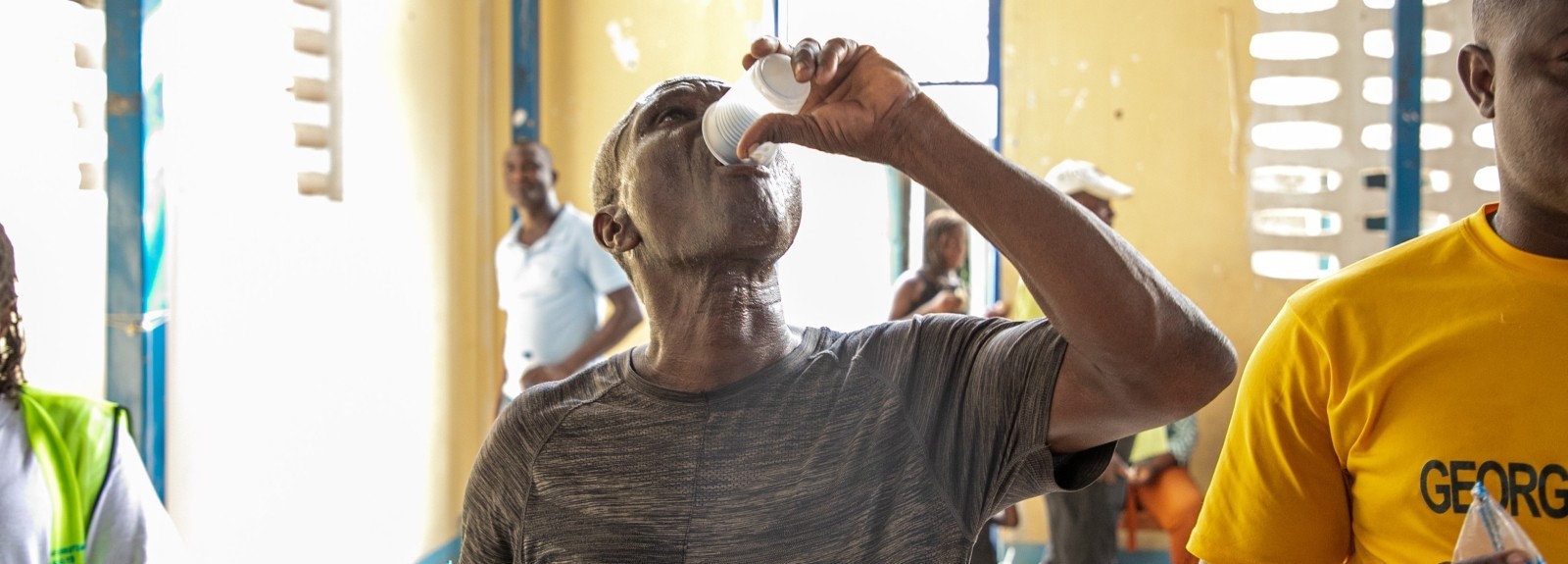This article was authored by the Centers for Disease Control and Prevention (CDC) and was originally published here. Through the CDC-funded Elimination of Lymphatic Filariasis in Haiti project, Corus organization IMA World Health works closely with the Haiti Neglected Tropical Disease Control Program (HNTDCP) to create evidence-based LF technical guidance documents, support the rollout of triple-drug therapy to treat LF, and implement awareness activities to enable communities to prevent, treat and control LF.
---
We recognize the progress CDC and global partners have made over the years, as well as the future work needed to prevent and eliminate neglected tropical diseases (NTDs). This year, we highlight an exciting mass drug administration (MDA) campaign that CDC, global partners, and the Haiti Ministry of Public Health and Population (MSPP) collaborated on in the commune of Limonade, Haiti.
About lymphatic filariasis
Lymphatic filariasis (LF), also known as elephantiasis, is an NTD caused by tiny filarial worms (parasites) that are transmitted through the bites of infected mosquitoes. If left untreated, LF can cause chronic, painful enlargement of body parts, often resulting in stigma, inability to attend school or work, and loss of family livelihoods. Annual mass drug administration (MDA) campaigns are a key strategy to stop the spread of infection. The World Health Organization (WHO) estimates that globally, 120 million people in 72 countries are infected with LF, and over 40 million people have LF-related disability. In the Americas region, only four countries continue to have LF: Guyana, Brazil (small area of the Amazon), the Dominican Republic, and Haiti. In the Americas, about 12.6 million people are at risk of infection—90% of these are in Haiti.
CDC’s involvement in LF elimination in Haiti
CDC has supported LF elimination in Haiti for over 30 years, most recently with support from the U.S. Agency for International Development (USAID). In 2001, LF mapping studies found that MDA campaigns were required in all of Haiti’s 140 communes. With CDC and USAID support, Haiti finally achieved national coverage in 2012 after they initiated treatment in the highly populated capital region of Port-au-Prince. Haiti’s LF program has been enormously successful. Today, almost all communes (87%), representing around 7 million people (65% of Haiti’s population), have been able to stop treatment because they live in communes where LF transmission has been interrupted. Despite this achievement, Haiti’s NTD program faces serious challenges in the communes that remain endemic–including ongoing security issues and community fatigue for continuing treatment campaigns in the face of other health concerns.
Triple-drug strategy to treat LF
Recently, CDC-led program research in Haiti from a DOLF multi-country clinical trial, which revealed that the addition of a third drug, ivermectin, to the standard MDA strategy of diethylcarbamazine and albendazole, is a more effective drug strategy to treat LF. From 2016–2018, CDC supported Haiti in conducting a community-based randomized trial involving more than 6,000 people. The trial compared the safety and efficacy of the new triple-drug strategy with the standard two-drug strategy for LF, resulting in the three-drug strategy as a safe and more effective way to eliminate LF. Based on these results from Haiti and similar findings from a handful of other countries, WHO now recommends using the new triple drug strategy in several LF-endemic regions, including the 18 communes in Haiti that still require MDA.
In 2021, CDC’s Division of Parasitic Diseases and Malaria (DPDM) received funding for a cooperative agreement with IMA World Health to support the Haiti Ministry of Public Health and Population (MSPP) in LF elimination efforts. A multi-disciplinary DPDM team has worked closely with the health ministry from project inception to implementation.
A girl consumes the LF treatment during the MDA campaign in Haiti.
Treatment campaign
October 2023 marked the conclusion of the Haiti MSPP’s MDA campaign that targeted all people at risk for LF (about 60,000 people) in the commune of Limonade in northern Haiti. This was the first time that Haiti’s national NTD program implemented an MDA campaign using the new, WHO recommended triple-drug strategy as opposed to the standard two-drug strategy. The treatment campaign, launched by the health ministry leadership, occurred September 27- October 12, 2023. During this time, teams of community drug distributors treated more than 45,000 people, achieving 74% population coverage—well above the WHO coverage target of 65%.
DPDM supported Haiti’s national program to focus on three strategic priorities:
- Interruption of LF transmission via implementation of triple drug therapy
- Alleviation of suffering to people affected by LF via morbidity management and disability prevention
- Strengthening LF surveillance through existing health care delivery and surveillance mechanisms
DPDM ensured that the Haiti NTD program’s treatment plans were in line with the priority areas, and met country needs as well as current global strategies and minimum WHO recommendations. DPDM also helped Haiti in planning and developing micro plans, which covered information on where and how many people would need to be treated, who would deliver treatments, as well as the dosage strategy and management of severe adverse events. Moreover, DPDM helped review community mobilization, training, and data collection tools for the new MDA approach.
Moving forward
This milestone adds to the journey of reaching interruption of transmission via provision of MDA, which is one of the key strategies to eliminate LF as a public health problem. More LF activities continue and will be reported on in the future. Eliminating LF in Haiti is one of DPDM’s strategic priorities, and CDC, along with partners such as USAID, is excited to support Haiti’s MSPP to continue its impactful work on this effort.

